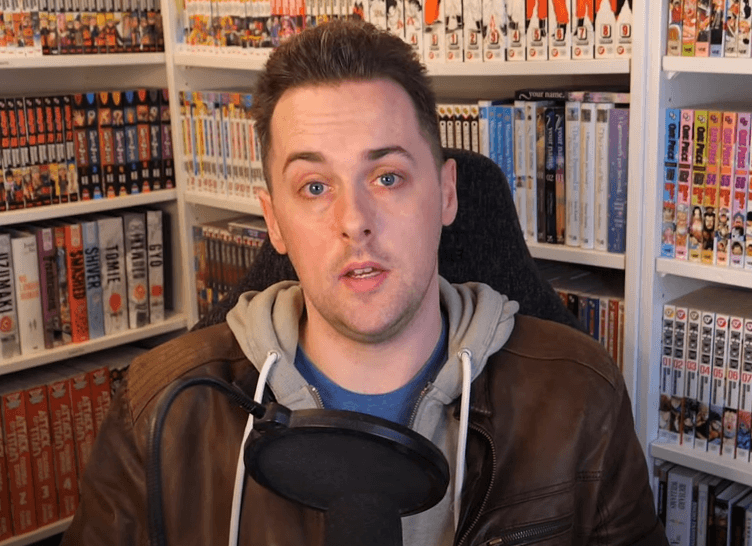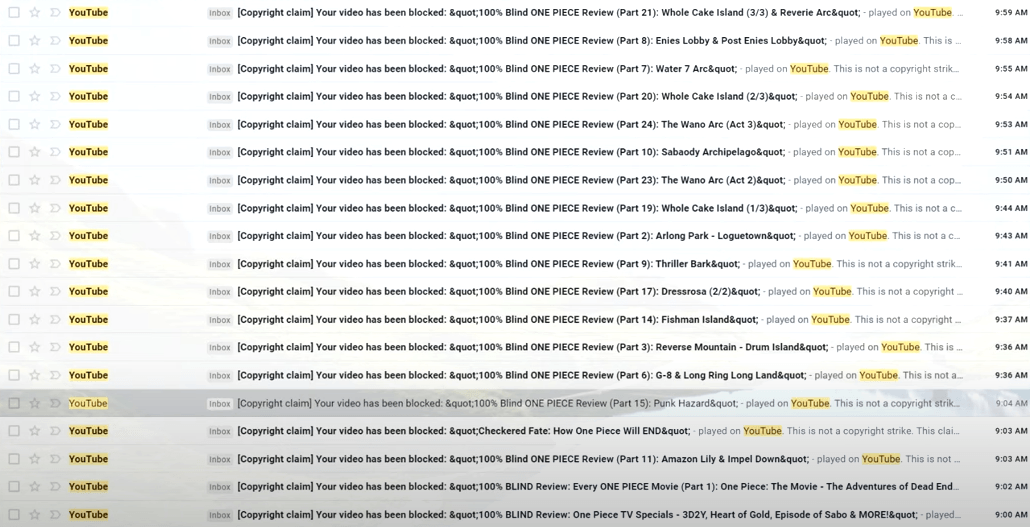 The 634K-subscriber YouTube channel ‘Totally Not Mark’ is in peril this morning after what can be described as a copyright takedown blitz by Japan-based animation company Toei.
The 634K-subscriber YouTube channel ‘Totally Not Mark’ is in peril this morning after what can be described as a copyright takedown blitz by Japan-based animation company Toei.
Famous for the Dragon Ball and One Piece series, among others, Toei Animation’s products are regularly reviewed in quite remarkable depth and detail by manga fanatic Mark Fitzpatrick, whose channel has in excess of 124 million views. Whether that can continue is up for debate.
“My name is Mark Fitzpatrick and my career is in jeopardy,” a video posted to YouTube begins. “Over the last 24 hours I’ve sat back in disbelief, shock and sorrow as my life’s work has been unfairly ripped away from me.”
Earlier this week Mark received an email saying that 15 of his videos had been copyright claimed by Toei. An hour later the number had grown to 28. By the time he published his latest video, the number of videos taken down by Toei had exceeded 150, a library that represents almost three years’ work.
Quite the surprise considering Mark’s claim that Toei previously approached him to do promotional work for the company.

Cries of ‘Fair Use’
In thousands of social media posts, comments and numerous articles posted since Mark’s announcement, a common theme persists. The reviews taken down by Toei are just that – commentary and criticism – a key factor when determining whether copyrighted content can be legally used under the US doctrine of fair use, without obtaining permission from rightsholders.
Mark feels this should protect his uploads from takedowns.
“I take my job very seriously. Because of this I ensure that both myself and my employees adhere strictly to the fair dealings and fair use policies as outlined by YouTube and within my own country and other countries,” he says.
“I am shocked and appalled that I, someone that tirelessly dedicates himself to a fair use practice has to accept and bend the knee as my life’s work gets obliterated before me by a massive company that clearly has no regard or respect for the rules outlined by YouTube themselves.”
We have no intention of conducting a detailed fair use analysis of Mark’s work and in most cases it’s something that YouTube doesn’t get deeply involved in either. However, the mention of an obviously commercial company relying on others’ copyrighted content to exist is not an element that helps to support a determination of fair use. It doesn’t guarantee failure either but does make success less likely when it comes to a court rendering a decision.
Any decision of that nature would be made under US copyright law but there have been some questions raised in the last few hours of whether Japanese law might need to be considered too, since there is famously no fair use in Japan.
As it happens, however, another ‘law’ is more immediately pertinent in this case – that of YouTube’s Content ID.
Content ID and the Law of YouTube
Processing what happened to Mark this week requires a basic understanding of the Content ID system, the mechanism through which four million claims are ‘settled’ each day on YouTube.
According to data released this week, rightsholders choose to monetize 90% of all Content ID claims, meaning that in exchange for not hitting a channel with a formal copyright complaint, they take the revenue from the targeted videos instead. In Mark’s case, Toei chose to have his videos removed entirely, despite having the ability to region-block if they wanted to. Even considering the lack of fair use in Japan, they could’ve left the content up elsewhere.
Mark believes that Toei didn’t consider the US doctrine of fair use at all, something that entities with access to Content ID should do as per their agreements with the platform. However, since an official copyright complaint hasn’t been filed under the DMCA, at this point copyright law hums along in the background while something much more immediate takes over – the Content ID dispute system.
“If you upload a video containing copyrighted content without the copyright owner’s permission, you could end up with a Content ID claim. The claim will keep you from monetizing the video, even if you only use a few seconds, such as short uses of popular songs,” YouTube explains.
“Automated systems like Content ID can’t decide fair use because it’s a subjective, case-by-case decision that only courts can make. While we can’t decide on fair use or mediate copyright disputes, fair use can still exist on YouTube. If you believe that your video falls under fair use, you can defend your position through the Content ID dispute process.”
The Dispute Process
Firstly, YouTube expressly advises uploaders not to upload any copyrighted content unless it’s absolutely essential to their videos, if they wish to avoid Content ID claims. While the amount of copyrighted content used under fair use can be a defense factor in a legal action, Content ID appears not to differentiate.
Importantly, YouTube’s Content ID and dispute process initially take place under the ‘laws of YouTube’ or, more accurately, contractual agreements, rather than copyright law.
So, in an initial response to the Content ID claims, Mark is not filing DMCA counternotices. Instead, he is having to manually dispute each of the 150+ hits in notices to YouTube and then Toei will get 30 days to respond to each. At this point Toei may release the claims, meaning that the videos and monetization will be restored. That would be the best possible outcome, beyond not claiming the videos in the first place of course.
However, they could reinstate the claims, which means that Mark will have to file an appeal for each yet again and wait another 30 days for a response. Worse still, if Toei chooses not to reinstate the claims, the company could take down the videos via DMCA copyright takedown requests, meaning that Mark could get copyright strikes against his account which could prove terminal under YouTube’s repeat infringer policy.
The Risks of Disputing Content ID Matches
The clear risk is that by disputing a Content ID match, YouTube users like Mark risk their channels receiving a copyright strike and in his case, risking the deletion of his entire account given the number of claims. And, by defaulting to the DMCA, the entire dispute process risks escalation to a courtroom, in this case to fight a fair use lawsuit which he may (or most likely may not) be able to afford.
In advance of that, however, rightsholders like Toei are given the opportunity to grant YouTube users a way out via a ‘scheduled copyright takedown request‘. This means that during the appeal process, a copyright holder can file a pending DMCA takedown notice that can be retracted if the YouTube user withdraws their appeal within seven days.
“By canceling, you’ll prevent the takedown and you won’t get a copyright strike. The Content ID claim will remain active on your video,” YouTube notes.
In Mark’s case, this means that Mark’s videos will stay down. It matters not whether his use was ‘fair’ or whether Toei’s claims under Content ID were valid. The whole process will have been settled in parallel but outside the DMCA process, meaning that any potential defenses are moot.
He will get to keep his channel though but with the majority of content removed it’s arguable what use that channel is good for. And, importantly, there is also the worry that Toei will run out of patience at any point in the process and issue DMCA complaints anyway, effectively ending Mark’s run on YouTube.
“Thank you all,” Mark now writes on Twitter.
“The other day I woke up to 150 claimed videos. Today I woke up to see so many creators large and small standing in solidarity alongside me. I don’t know what will happen with this. But know that this solidarity on its own sends a strong message.”
This raises a serious question: when an obvious promoter of premium content gets treated in the way Mark has, regardless of whether there is a fair use defense or not, is that good or bad for a company like Toei and the sales it appears to be determined to protect?
Content recognition mechanisms often exist to punish pirates yet when they are used in a manner that leaves both promoters and paying fans in despair, surely it’s time to have a meaningful and open conversation about the end goals.
It’s certainly not too late in this case and something particularly positive could be the outcome. The alternative is to have YouTubers shy away from Toei content in its entirety or produce bland reviews that nobody wants to watch.
From: TF, for the latest news on copyright battles, piracy and more.
0 Commentaires